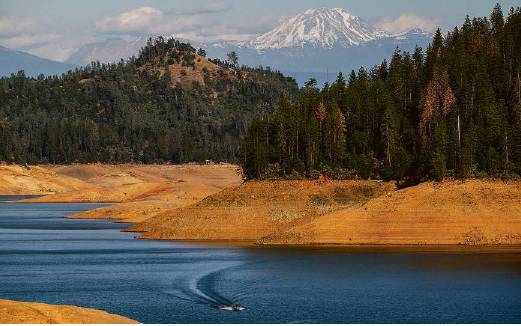California residents increasing water use
Newsom’s pleas falling on deaf ears amid drought
By Kurtis Alexander
With a record dry start to 2022, Californians have begun using more water — not less, like the governor has asked for — leaving the state well short of its drought-time conservation goal of 15% savings.
State data released Tuesday shows urban water consumption across California rose 2.6% in January, compared to the same month in 2020. Some cities and towns, though, increased water use nearly 50% in January. The state’s cumulative water savings since July, when Gov. Gavin Newsom first called for voluntary reductions, was 6.4%, less than half of what was requested.
The failure of residents to comply, and sometimes save no water at all, puts increased pressure on California’s water supplies, which are already squeezed as the state enters a third year of drought. The lackluster conservation also puts pressure on the governor to ratchet up his ask of Californians.
“We all must do more to adjust and adapt,” Newsom’s office said in a statement Tuesday.
The State Water Resources Control Board, which regulates and tracks California’s water use, has already enacted prohibitions on certain outdoor water activities to encourage savings, including watering lawns within 48 hours of rain and hosing down driveways. But the agency, at the direction of the governor, has not turned to mandatory statewide caps on consumption like the strict water-rationing that was implemented during last decade’s five-year drought.
Charlotte Ely, a senior environmental scientist and conservation program lead for the State Water Board, said there was certainly “untapped potential” for more voluntary savings.
January’s increase in water use was driven largely by thirsty inland parts of the state. More than anywhere, the southern deserts and Central Valley have reeled from little rainfall and mild temperatures during what is historically California’s cold, wet season.
Among those who increased consumption the most, based on their year-over-year use, were the cities of Manteca, Kingsburg and Tracy in the San Joaquin Valley, which upped their intake by 51.1%, 47.9% and 38.3% respectively, according to the state data.
The Bay Area was one of the few regions in California to continue conserving in January, though water use dropped just 1.4%, the data shows. Since July, the region, defined by the State Water Board as the watershed from roughly south of Santa Rosa to San Jose and much of the East Bay, has saved 11% cumulatively, well above the state average but still shy of the state target.
The lack of savings, water experts say, is a combination of the dry weather, which means using more water to keep lawns green, on top of other issues, from COVID-19 to politics, that are diverting people’s attention.
“We have had many things on our minds these past two years, and water is still not a big concern,” said Alvar Escriva-Bou, a senior fellow at the Water Policy Center at the Public Policy Institute of California.
A recent survey done by the Water Policy Center found that drought doesn’t rank among the top five concerns of Californians, whereas at the height of last decade’s drought in 2015, water was the top concern of nearly 40% of state residents.
The governor’s office earlier this week announced an additional $22.5 million in spending on drought response, more than a third of which was dedicated to doing outreach.
“We have increased our efforts to communicate with all Californians about what they can do to conserve water, and the importance of conservation amid these dry conditions,” the governor’s office said Tuesday.
The office added: “Local water suppliers also have an important role to play in this effort, and have to step up to ensure regional water goals are met.”
The past two years were among the driest California has experienced in modern times, and after sparse rain and snow this January and February, another year of drought appears imminent. Some parts of the state saw no measurable rain during the first two months of 2022, while San Francisco, San Jose, Sacramento, Redding and Stockton all set records for their driest start to the year.
“Typically, in most of California, December, January and February are the wettest months,” said Brooke Bingaman, a meteorologist with the National Weather Service in Monterey. “When two of those months were abnormally dry, that puts a dent in what (water) we had hoped to get in the winter season.”
Despite a few rounds of showers in many parts of the state this week — through at least Saturday — Bingaman said total rainfall wouldn’t be much, given the deficit.
Reservoirs across the state, where California gets most of its water, are sometimes alarmingly low. Shasta Lake, the state’s biggest, was 38% full this week, about half of what it typically contains this time of year. Lake Oroville, the second biggest, was at 46% of capacity, about two-thirds of what it typically contains.
Many communities, especially those reliant on diminishing reservoirs, have already put mandatory water restrictions in place. Some water experts have urged the governor to follow suit with statewide water restrictions.
Kurtis Alexander is a San Francisco Chronicle staff writer. Email: kalexander@sfchronicle.com Twitter: @kurtisalexander
“We have had many things on our minds these past two years, and water is still not a big concern.”
Alvar Escriva-Bou, senior fellow at Water Policy Center
